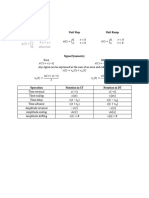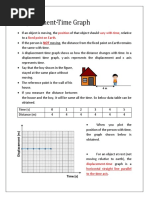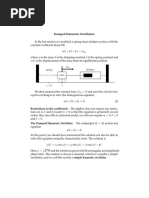Unit 1 Tutorial
Uploaded by
joshinihar19Unit 1 Tutorial
Uploaded by
joshinihar191.
Prove the properties of doublet function
𝑡
a. ∫𝑡 2 𝑥(𝑡) 𝛿 ′ (𝑡 − 𝑡0 )𝑑𝑡 = −𝑥′(𝑡0 ) for 𝑡1 < 𝑡0 < 𝑡2
1
b. 𝑥(𝑡)𝛿 ′ (𝑡 − 𝑡0 )𝑑𝑡 = 𝑥(𝑡0 )𝛿 ′ (𝑡 − 𝑡0 ) − 𝑥′(𝑡0 )𝛿(𝑡 − 𝑡0 )
𝑡
c. ∫−∞ 𝛿 ′ (𝜏 − 𝑡0 )𝑑𝜏 = 𝛿(𝑡 − 𝑡0 )
2. Prove the properties of discrete time impulse function.
3. Prove the following relationships.
𝑑𝑢(𝑡) 𝑡
a. = 𝛿(𝑡) or 𝑢(𝑡) = ∫−∞ 𝛿(𝜏) 𝑑𝜏
𝑑𝑡
𝑑𝑟(𝑡) 𝑡
b. = 𝑢(𝑡) or 𝑟(𝑡) = ∫−∞ 𝑢(𝜏) 𝑑𝜏
𝑑𝑡
4. Draw the waveform for following signals.
a. 𝒙(𝒕) = 𝒖(𝒕 + 𝟐)
b. 𝒙(𝒕) = 𝒖(𝒕 − 𝟐)
c. 𝒙(𝒕) = 𝒖(−𝒕)
d. 𝒙(𝒕) = 𝒖(−𝟐𝒕 + 𝟏)
e. 𝒙(𝒕) = 𝒖(−𝟐𝒕 − 𝟏)
f. 𝒙(𝒕) = 𝒖(𝒕 + 𝟐) − 𝒖(𝒕 − 𝟐)
g. 𝒙(𝒕) = 𝒖(𝒕) − 𝟐𝒖(𝒕 − 𝟏) + 𝒖(𝒕 − 𝟐)
𝒅
h. 𝒙(𝒕) = 𝒅𝒕 [𝒖(𝒕 + 𝟐) − 𝒖(𝒕 − 𝟐)]
𝒅
i. 𝒙(𝒕) = 𝒅𝒕 [𝒖(𝒕) − 𝟐𝒖(𝒕 − 𝟏) + 𝒖(𝒕 − 𝟐)]
5. Draw the waveform of following signals.
a. 𝑥 (𝑡 ) = 𝑟 ( 𝑡 − 1)
b. 𝑥 (𝑡 ) = 𝑟 ( 𝑡 + 2)
c. 𝑥(𝑡) = 𝑟(−𝑡)
d. 𝑥(𝑡) = 𝑟(3𝑡)
e. 𝑥(𝑡) = 𝑟(−3𝑡)
f. 𝑥(𝑡) = 𝑟(3𝑡 + 1)
g. 𝑥(𝑡) = 𝑟(−3𝑡 − 1)
h. 𝑥 (𝑡 ) = 𝑟 ( 𝑡 ) − 𝑟 (𝑡 − 1 )
i. 𝑥(𝑡) = 𝑟(𝑡) − 2𝑟(𝑡 − 1) + 𝑢(𝑡 − 2)
𝑑
j. 𝑥(𝑡) = 𝑑𝑡 [𝑟(𝑡) − 𝑟(𝑡 − 1)]
𝑑
k. 𝑥(𝑡) = 𝑑𝑡 [𝑟(𝑡) − 2𝑟(𝑡 − 1) + 𝑢(𝑡 − 2)]
6. Draw the waveform of following signals.
a. 𝑥(𝑡) = 𝑟(𝑡) − 𝑟(𝑡 − 1) − 𝑢(𝑡 − 1)
b. 𝑥(𝑡) = 𝑢(𝑡) + 𝑟(𝑡) − 2𝑟(𝑡 − 1) + 𝑟(𝑡 − 2) − 𝑢(𝑡 − 2)
c. 𝑥(𝑡) = −𝑢(𝑡 + 1) + 𝑟(𝑡 + 1) − 𝑟(𝑡 − 1) − 𝑢(𝑡 − 1)
𝑑
d. 𝑥(𝑡) = 𝑑𝑡 [𝑟(𝑡) − 𝑟(𝑡 − 1) − 𝑢(𝑡 − 1)]
e. 𝑥(𝑡) = 𝑢(𝑡 + 1) − 𝑢(𝑡) + 𝑟(𝑡) − 𝑟(𝑡 − 1) − 𝑢(𝑡 − 1)
𝑑
f. 𝑥(𝑡) = 𝑑𝑡 [−𝑢(𝑡 + 1) + 𝑟(𝑡 + 1) − 𝑟(𝑡 − 1) − 𝑢(𝑡 − 1)]
7. Check whether the following signal are periodic or aperiodic signal. In case of periodic
signal find the period of the signal.
a. x(t) = sin(π t/4)
b. x(t) = sin(π t/6) + 3 cos(π t/4)
c. x(t) = sin(2π t/5) cos(4π t/3)
d. x(n) = cos(8π n/15)
e. x(n) = sin (4n)
f. x(n) = sin (3π n/4) + sin (π n/3)
g. x(n) = e-j π n/6
8. Consider an energy signal 𝑥(𝑡) with energy 𝐸𝑥 ,
Find the energy of −𝑥(𝑡), 𝑥(−𝑡), 𝑥(𝑡 − 𝑇), 𝑥(𝑎𝑡), 𝑥(𝑎𝑡 − 𝑏), and 𝑎𝑥(𝑡).
9. Determine whether the following power or energy signals or neither.
a. 𝑥(𝑡) = 𝐴 sin( 𝑡) −∞<𝑡<∞
b. 𝑥(𝑡) = 𝐴([𝑢(𝑡 + 𝑎) − 𝑢(𝑡 − 𝑎)] 𝑎>0
c. 𝑐. 𝑥(𝑡) = 𝑒 −𝑎|𝑡| 𝑎>0
d. 𝑥 (𝑡 ) = 𝑢 (𝑡 )
e. 𝑥(𝑡) = 𝑟(𝑡) = 𝑡𝑢(𝑡)
10. Determine the values of 𝐸𝑥 and 𝑃𝑥 for each of the following signal.
a. 𝑥(𝑡) = 𝑒 −2𝑡 𝑢(𝑡)
𝜋
b. 𝑥(𝑡) = 𝑒 𝑗(2𝑡+ 4 )
c. 𝑥(𝑡) = 𝐴 cos(𝑡)
1 𝑛
d. 𝑥(𝑡) = ( ) 𝑢(𝑡)
2
𝜋 𝜋
e. 𝑥(𝑡) = 𝑒 𝑗( 4 𝑛+ 8 )
𝜋
f. 𝑥(𝑡) = cos ( 4 𝑛)
11. Prove all the properties of continuous time & discrete time even and odd signals.
12. Prove the following.
𝑥(𝑡) + 𝑥(−𝑡) 𝑥 (𝑡) − 𝑥(−𝑡)
𝑥 𝑒 (𝑡 ) = and 𝑥 𝑜 (𝑡 ) =
2 2
13. Determine the even and odd part of following signals.
a. u(n), Draw the waveform for even and odd parts.
b. u(t), Draw the waveform for even and odd parts.
c. 𝑥(𝑡) = 𝑒 −2𝑡 cos(𝑡)
14. Check the linearity of the following systems.
a. y(t) = t x(t)
b. y(t) = x2(t)
c. y(t) = 2 x(n) – 3
15. For the system described by the following equations, determine linearity of the systems.
𝑑
𝑎. 𝑦(𝑡) + 3𝑦(𝑡) = 𝑥(𝑡)
𝑑𝑡
𝑑
𝑏. 𝑦(𝑡) + 2𝑦(𝑡) = 𝑥 2 (𝑡)
𝑑𝑡
𝑑2
𝑐. 2 𝑦(𝑡) + 2𝑦(𝑡) = 𝑥(𝑡)
𝑑𝑡
𝑑
𝑑. 𝑦(𝑡) + 3𝑦(𝑡) + 4 = 𝑥(𝑡)
𝑑𝑡
16. Prove the scaling property of continuous time unit impulse function.
17. Prove that continuous time unit impulse function is an even function.
18. Prove that 𝑠𝑔𝑡(𝑡) = −1 + 2𝑢(𝑡)
You might also like
- 4 the Derivative as the Slope of the Tangent Line (1) (1)No ratings yet4 the Derivative as the Slope of the Tangent Line (1) (1)41 pages
- Math 11: Calculus I Differential CalculusNo ratings yetMath 11: Calculus I Differential Calculus9 pages
- Industrial Safety Engineering Assignment 0No ratings yetIndustrial Safety Engineering Assignment 03 pages
- Continuous Time Signals Part I Fourier SeriesNo ratings yetContinuous Time Signals Part I Fourier Series12 pages
- 10-1 and 13-1 Overheads (Landscape) PDFNo ratings yet10-1 and 13-1 Overheads (Landscape) PDF10 pages
- AB Chapter 2 Part 1 (sections 2.1 - 2.4) HOMEWORKNo ratings yetAB Chapter 2 Part 1 (sections 2.1 - 2.4) HOMEWORK9 pages
- CorelH - Mechanical Vibratio - Homework1 - 003202305011No ratings yetCorelH - Mechanical Vibratio - Homework1 - 0032023050114 pages
- Math-103-2023-24-More-Practice-Problems-1 2No ratings yetMath-103-2023-24-More-Practice-Problems-1 272 pages
- WORKSHEET-Partial Differentiation, ApplicationsNo ratings yetWORKSHEET-Partial Differentiation, Applications2 pages
- Design of State Variable Feedback and State ObserverNo ratings yetDesign of State Variable Feedback and State Observer4 pages
- Trigonometric Ratios to Transformations (Trigonometry) Mathematics E-Book For Public ExamsFrom EverandTrigonometric Ratios to Transformations (Trigonometry) Mathematics E-Book For Public Exams5/5 (1)
- Finite Element Analysis of Natural Whirl Speeds of Rotating ShaftsNo ratings yetFinite Element Analysis of Natural Whirl Speeds of Rotating Shafts7 pages
- One Way Ride On The SAT & EST Systems of Linear Equations & LinearNo ratings yetOne Way Ride On The SAT & EST Systems of Linear Equations & Linear8 pages
- It Is Compulsory To Submit The Assignment Before Filling in TheNo ratings yetIt Is Compulsory To Submit The Assignment Before Filling in The6 pages
- Experiment No-1: To Measure The Unknown Value of Inductance Using A Maxwell Bridge100% (1)Experiment No-1: To Measure The Unknown Value of Inductance Using A Maxwell Bridge3 pages
- Surface Electromagnetics With Applications in Antenna Microwave and Optical Engineering Fan Yang Download PDF100% (9)Surface Electromagnetics With Applications in Antenna Microwave and Optical Engineering Fan Yang Download PDF49 pages
- FEA-Academy Courses - Practical Basic FEA - 6-LecturesNo ratings yetFEA-Academy Courses - Practical Basic FEA - 6-Lectures13 pages
- Rotor Spinning Process: Md. Mazbah Uddin Bangladesh University of Textiles Yarn Engineering Departmet Batch 08100% (1)Rotor Spinning Process: Md. Mazbah Uddin Bangladesh University of Textiles Yarn Engineering Departmet Batch 0861 pages
- Multiplication Properties Flip Book RubricNo ratings yetMultiplication Properties Flip Book Rubric1 page
- Assignment 2: Engineering Graphics - CAD / 19MEE100No ratings yetAssignment 2: Engineering Graphics - CAD / 19MEE1002 pages
- Computer Graphics: Unit 3 Overview of TransformationsNo ratings yetComputer Graphics: Unit 3 Overview of Transformations85 pages
- CBSE-X Chapterwise (Previous Years) Qs - Science & Maths-Min (Dragged) 13No ratings yetCBSE-X Chapterwise (Previous Years) Qs - Science & Maths-Min (Dragged) 131 page
- Balanced and Unbalanced Forces Class ActivityNo ratings yetBalanced and Unbalanced Forces Class Activity6 pages
- Three Ways To Define The Poisson ProcessNo ratings yetThree Ways To Define The Poisson Process23 pages
- 440 HTZ OU 432 HTZ .... VIBRAÇÕES, PerigosNo ratings yet440 HTZ OU 432 HTZ .... VIBRAÇÕES, Perigos2 pages
- Gear Pump Performance Test: Mechanical Engineering Department ME-Laboratory 2 Manual Experiment 4No ratings yetGear Pump Performance Test: Mechanical Engineering Department ME-Laboratory 2 Manual Experiment 418 pages
- MAE 322 Machine Design: Dr. Hodge Jenkins Mercer UniversityNo ratings yetMAE 322 Machine Design: Dr. Hodge Jenkins Mercer University20 pages
- Damped Harmonic Oscillators: Spring Mass X Dashpot FNo ratings yetDamped Harmonic Oscillators: Spring Mass X Dashpot F3 pages

































































































